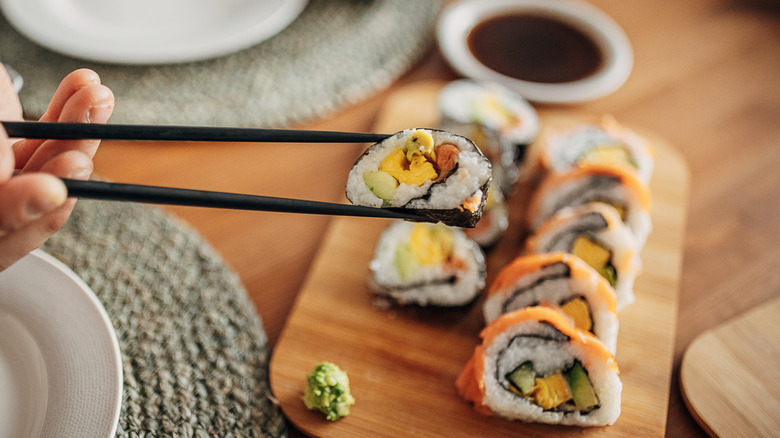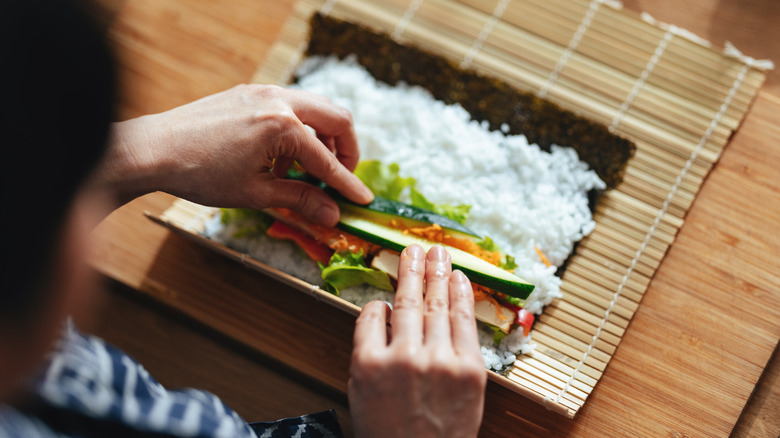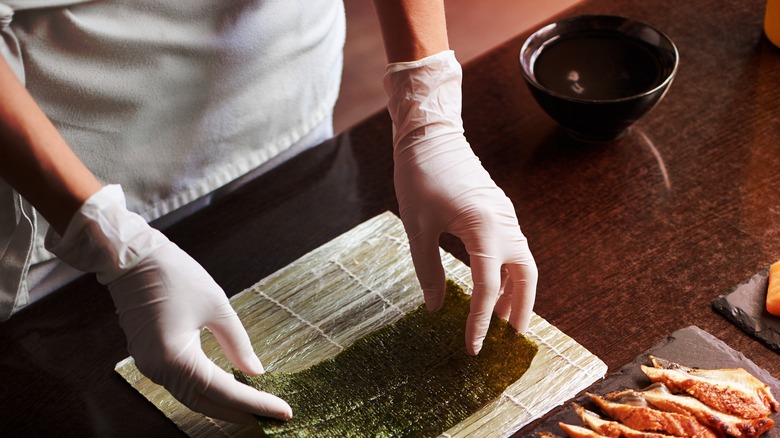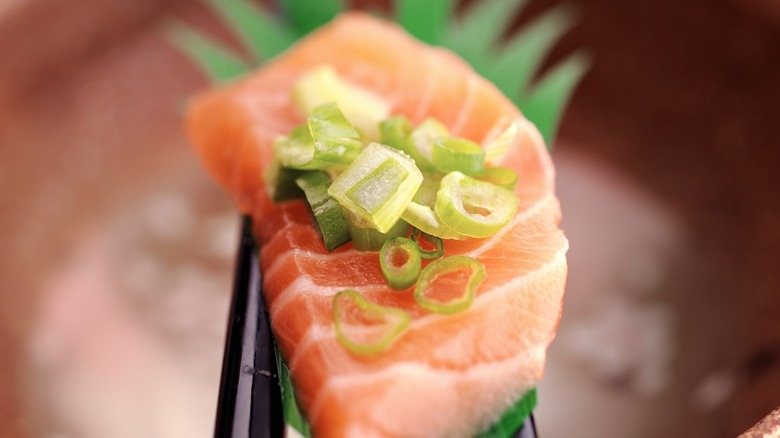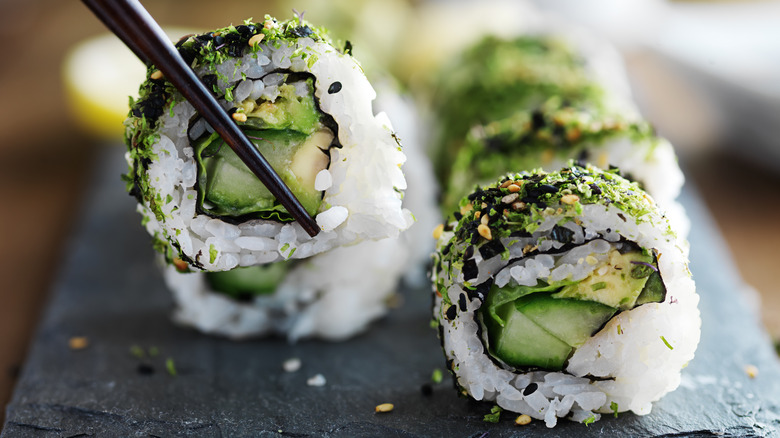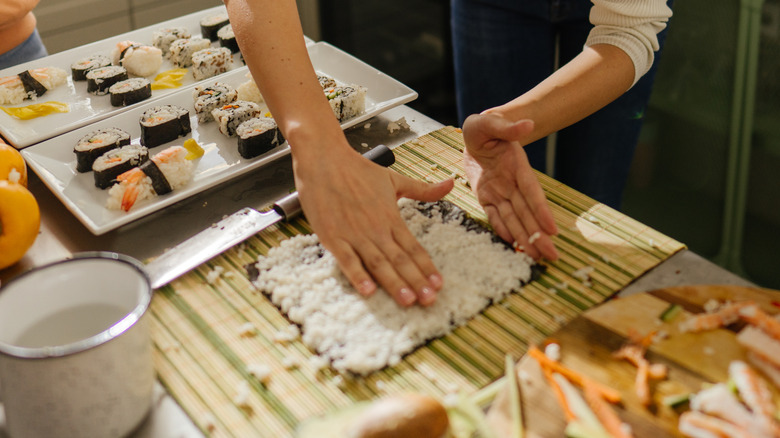Expert Tips For At-Home Sushi Beginners
Going out for sushi is a wonderful experience — you're treated to stunning cuts of fish and veggies, all artfully plated and arranged, and you can even watch the chefs work their magic. In addition to being delicious, however, high-quality sushi can be wildly expensive, so why not try making sushi at home? This is an intimidating task, so we consulted an expert to get some tips and learn what sushi-making mistakes to avoid. Jeff Miller is a partner and chef at Rosella and Bar Miller, two New York City restaurants specializing in sustainably-sourced sushi.
Miller's first piece of advice for embarking on your homemade sushi journey is to invest in some basics. "Making sushi at home will require at least a small investment in equipment, but with it, you'll be able to make sushi at home for the rest of time," he told Mashed. You'll need a rice cooker (Miller recommends the brand Zojirushi), a hangiri and a shamoji (a traditional sushi-making bowl and spatula, respectively, though a standard bowl and spatula will work), a makisu or sushi mat, and a sharp knife.
Miller's other five tips for beginning your sushi prep are fairly simple: learn the basics, keep a bowl of water nearby while working with rice, only use top-quality fish from reputable sellers, don't sleep on vegetarian sushi, and accept that trial and error are a normal part of the sushi-making process.
1. Start out simple
If you're a sushi newcomer, it'll be a while before you can slice and dice fish and shellfish with graceful precision. Jeff Miller recommends starting with basic hand rolls until you develop your skills, saying, "For those new to making sushi, start with rolls or hand rolls — there are endless instructional videos out there. Once you're comfortable with cooking and handling rice, you can work your way up to making nigiri."
Maki rolls are probably what come to mind when you think of sushi; they're made by rolling a mixture of ingredients in a tube of rice and often dried seaweed (nori). To eat the roll, you have to slice it into bite-sized wheels. These pieces, traditionally eaten as finger food, are often accompanied by a hot towel for cleaning the hands. Nigiri, on the other hand, consists of fish or shellfish atop a small bed of rice. As "nigiri" translates to "two fingers," this is the standard mode of eating the dish. When making nigiri, you're crafting individual sushi bites rather than one long roll, meaning much more assembly is required to make a full meal.
2. Keep a bowl of water nearby
Making sushi requires sushi rice. Its high starch content and short, round grains are ideal for all sushi types, as they stick together and provide structure. The only problem? The same gluey quality that makes this rice perfect for sushi also makes it difficult to work with. Your hands can easily become covered in rice while you're trying to form a layer on your mat.
Jeff Miller's advice is simple: "Keep a water bowl on hand to periodically dip your fingers into and wet your hands — the right amount of moisture on your hands is essential." This tip will ensure the rice sticks to itself and your sushi ingredients, not your hands. Just be mindful not to wet your fingers excessively, as this can create a soggy mess. You can also try adding a dash of sushi vinegar to the water, which will help maintain the rice's typical, slightly acidic flavor rather than wash it away.
3. Spring for high-quality fish
If you intend to serve your fish raw, which is usually the case for sushi rolls and nigiri, it's paramount that you buy from a "reliable source," as Jeff Miller puts it. Part of what makes restaurant sushi so outstanding is the ingredients' quality — the chefs aren't just using whatever salmon they can find at the grocery store. Instead, they use what's called sushi-grade fish. One myth about sushi-grade fish is that it's a label bestowed upon certain fish vendors who adhere to a specific set of regulations and practices. In truth, the moniker references the overall quality of the fish, not necessarily how safe it is to consume. For the sake of both flavor and safety, however, you should always aim for raw fish of the highest quality.
Go to a reputable fishmonger or fish market where you can speak directly to the person handling the product. Feel free to inquire about processing, when the fish was caught and arrived at the store, if it was flash-frozen to eliminate parasites, if any artificial coloring was added, and so on. Worth noting is that frozen fish can actually be a better choice than fresh, so don't be afraid to peruse the frozen section. If your sushi's fish has gone bad, you can tell by its dull color, slimy or flaky texture, and off smell.
4. Don't dismiss veggie rolls
Now that we've determined how to buy fish for your homemade sushi, let's focus on another important factor: your other ingredients. When dreaming about your future as a sushi chef, you no doubt envision yourself slicing razor-thin pieces of salmon and tuna, but you don't actually need fish, shellfish, or really any meat to make sushi. Jeff Miller warns against dismissing vegetarian rolls, saying, "Veggie sushi can be equally [as] good" as its fishy counterpart.
To make your veggie rolls stand out, add some variety. Miller says, "I love a mix of fresh and cooked ingredients, and I use a generous amount of herbs." For example, try using a bit of raw cucumber alongside some charred scallions and a few cilantro leaves. Additionally, marinated veggies like oshinko (pickled radish) give your vegetarian sushi roll wonderful acidity and texture. Avocado can also provide some plant-based fat and creaminess.
5. Be patient and trust the process
Professional sushi chefs can take up to 10 years to master their art, the first of which may not even involve any fish. If you're going to start making your own sushi, it's important to accept that you won't become a master overnight.
Jeff Miller, who's been working with sushi professionally for several years, said, "When it comes to actually making the sushi, know that it'll require a good amount of trial and error, and getting used to handling sushi rice takes time." Instead of expecting your first sushi attempts to look like works of art, enjoy the experience and satisfaction that comes from trying a new culinary skill, and be sure to mark your progress over time.
